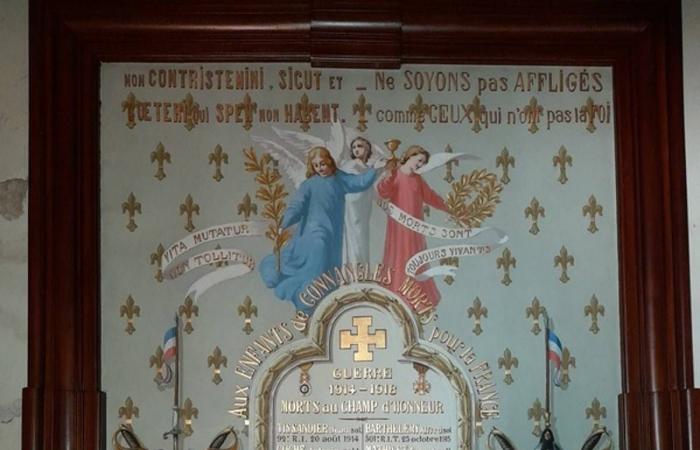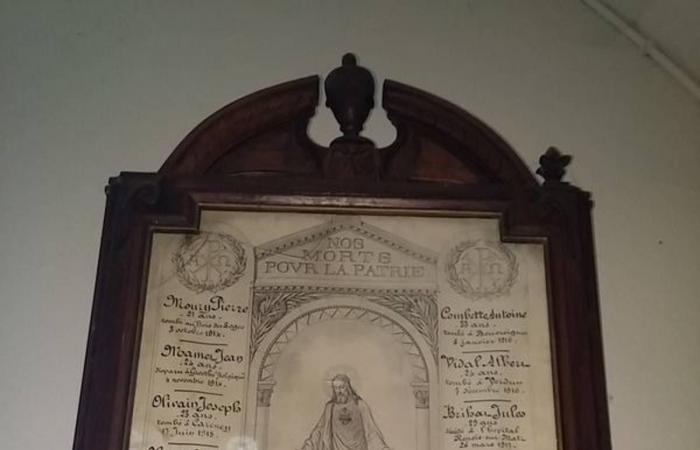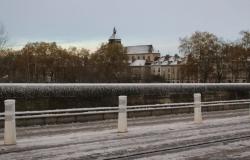On the eve of November 11, Richard Crespy, professor of history and geography and local historian, focuses on the commemorative plaques of the First World War in churches and their specificities.
It is a little-known memory which nevertheless has its place in the history of the conflict and its long-term repercussions: the commemorative plaques of the First World War in churches. They benefit from natural protection within religious buildings, but their sustainability is absolutely not assured since they are not subject to protective administrative classification. However, in certain communes (in the former cantons of Saugues or Monastier for example), they constituted and still constitute the only public tribute to the soldiers who died during the conflict.
A request from 1919
In the spring of 1919, the Religious Week of the diocese of Puy mentioned “the numerous requests sent to the bishopric by priests who wish to install nameplates of dead soldiers inside religious buildings.” In Haute-Loire, the first mention found concerns the town of Céaux-d'Allègre, on April 27. Some municipalities had chosen to install their official monument within the church (such as Blavozy, Saint-Germain-Laprade or Les Estables) and others have dedicated stained glass windows to the conflicts (Chaspuzac, Valprivas).
The plaques are “only a simple page of history” and in no way an act of worship in themselves, an object of particular devotion. Their objectives are “to increase devotion to the souls in Purgatory and to prevent the victims of war from falling into oblivion”. The question of the presence of Protestants on these plaques is interesting. Although ecumenism has made progress, a certain distrust still prevails. In Chambon-sur-Lignon, the plaque installed in the Catholic church only mentions five names, which is very few compared to the number of deaths in the commune which exceeds a hundred.From the inscriptions to the choice of materials, each one tells a story, that of an era and its inhabitants. Photos Dr
Compared to a public memorial, the cost of creation is of course lower. This therefore allows for speed in production, but it also poses a statistical problem. Indeed, the definitive list of war dead was absolutely not drawn up at the time these plaques were installed – essentially between 1919 and 1921. Sometimes, as at Monastier-sur-Gazeille, one or more were added to the list. names a posteriori. Furthermore, since the separation of Church and State in 1905, the ownership of religious buildings fell to the municipalities. The project was generally initiated by the parish priest, but he had to obtain the agreement of the mayor. No opposition was noted in Haute-Loire. Still in Monastier, subscriptions from the population were used to install the two commemorative monuments which were inaugurated on the same day. In Cubelles, on September 19, 1920, the archpriest of Saugues “thanks the Mayor and the municipal council for having consulted with the Priest to place in the church the plaque that has just been blessed”.
Everyone has their place…
Churches had a natural vocation to become memorial sites of the war. Widespread religious practice, the comfort brought to bereaved families through acts of worship and the vigor of patriotic feelings among many ecclesiastics played in this favor. Before November 11 became a day of national commemoration in 1922, All Saints' Day and November 2 were marked by ceremonies honoring the war dead. This practice remains in many localities after the end of the conflict. The location of the plaques varies depending on the building. They can be found in the vestibule as in Rosières, near an entrance door as in Freycenet-la-Cuche, Brives-Charensac or Yssingeaux. We also have plaques on pillars as in the Ponote churches of the College or the Carmelites as well as in Craponne. Most often, they are on the side walls. The materials used are varied with a dominance of marble and wood. …
And his choice of registration
The registrations are interesting because they can provide information on the financing of the project. We of course find the name of the locality with the mention “parish” or “commune”. As on public monuments, we have the dates of the conflict, sometimes the years of death of the soldiers, rarely the ranks (Sainte-Florine). In Ouides and Connangles, an extract from a famous patriotic poem by Victor Hugo was added. In Blanzac, the names of the donors were indicated. The inscription “God and Fatherland” is very common. But what matters above all is the fate of the souls of the deceased. The mention of the verb “to pray” as well as various Latin religious formulas are supposed to remind us of this. Wooden plaques were made
Wooden plaques were made
Finally, a particularity of Haute-Loire: the inscription of the dead according to the villages of origin which we find in many buildings (Bains, Présailles, Cayres or Laussonne), a spirit more present in Velay than in the Brivadois. Conversely, we find more rarely medallions with the portrait of the deceased as in Auvers or in the church of Verne, commune of Lapte. A statue very often accompanies the commemorative plaques, of the Virgin (in Saint-Étienne-du-Vigan and Pinols) but especially of Joan of Arc. His canonization in 1920 is of course not unrelated to this presence in Brignon, Vielprat, Saint-Pal-de-Mons, Chavaniac-Lafayette or Saint-André-de-Chalencon.
And the presence of a tricolor flag is quite common even if it is not necessarily self-evident. There, it is the Church which will move in the direction of appeasement. The reestablishment of diplomatic relations between France and the Vatican in 1921 explains this development, which also made it possible to validate the plaques with this decoration.
Few traces of the inaugurations
Afterwards, the inaugurations are more difficult to know than those which concerned public monuments. In Saint-Geneys-près-Saint-Paulien, it resulted in a simple blessing at the end of the homily on February 1, 1920. The mayor made the roll call to which one of his deputies responded with “Fell in the field of death.” 'honor' alternating with 'Death for France'. The audience completes by adding: “Lord, give him eternal rest.” In Tence, on April 7, the plaques were inaugurated in the presence of the Bishop of Puy, Mgr Boutry. In Freycenet-la-Cuche, veterans are in uniform and armed to “pay honors to their comrades”. In Présailles, on September 13, 600 people took part in the ceremony (latecomers cannot enter the church), including priests from neighboring parishes, religious people from the town and workers from the Transcévenole construction site.
The difficult census
The inventory of commemorative plaques in churches is not so simple. Sometimes, they may have disappeared during renovation work, as for Saint-Laurent in Puy in the 1970s. There is also the particularity of the buildings in the sections of municipalities. The churches of the villages of Brugeilles (Torsiac), Verne (Lapte), Sarlanges (Retournac) have a commemorative plaque. Conversely, in Espaly or Aiguilhe, the Saint-Joseph basilica and the Saint-Michel chapel do not have one. If the public war memorial is installed near the church, or even attached to it, the presence of a plaque inside is not guaranteed, this is the case for example in Landos or Saint-Victor -Malescours. Protestant temples must also be taken into account, knowing that Reformed trends were moving in the direction of paring down places of worship. However, in Tence, Freycenet-Saint-Jeures and the Montbuzat section, we find name plaques in the temples with an extract from the Bible: “There is no greater love than to lay down one’s life” for the first, “Your brother will rise again” for the second and “Blessed are the peacemakers” for the third. “Our deaths for the country”, a plaque honoring the soldiers who died for the country.
“Our deaths for the country”, a plaque honoring the soldiers who died for the country.
Some are worth the detour…
Some plaques are worth a detour because of their overall composition. In Saint-Julien-d'Ance, angels and the Virgin embellish a plaque which has many sculpted details, while in Sainte-Florine, there are soldiers in different postures as well as a Vercingétorix standing guard. There are also very well preserved nominative paintings such as in Connangles or Saint-Didier-sur-Doulon. At La Chomette, the names of the deceased were written in beautiful calligraphic writing. In Yssingeaux, the black marble plaque is inserted in a table made of mosaics showing the coat of arms of the town, fire pots as well as a dominant representation of the holy spirit. The whole is preceded by a wooden recumbent figure representing Christ and it was inaugurated on September 28, 1920.
All our photos and videos of the big hot air balloon gathering in Velay on Saturday
Finally, we should point out the plaques on wood from the churches of Salettes and Lafarre. The latter was the subject of a successful restoration in 2018 by apprentices from the CFA de Bains. These are unique works from the same workshop, finely sculpted and which also include metal plaques, also sculpted, bearing the names of soldiers who died in the war, the wounded and prisoners. The most complete is that of Salettes, inaugurated in May 1919. It is both a remarkable artistic work and an unrivaled historical source for this small town. As such, the latter deserves a classification which would ensure its sustainability for future generations.








